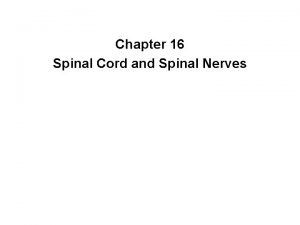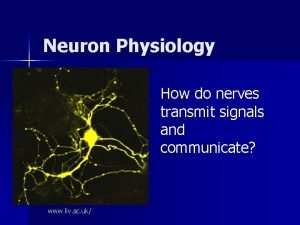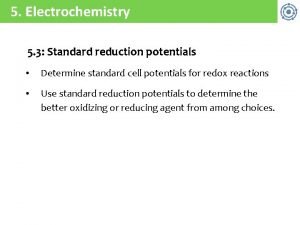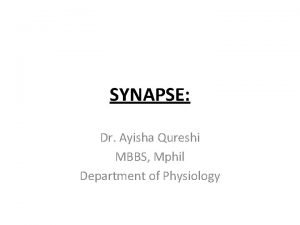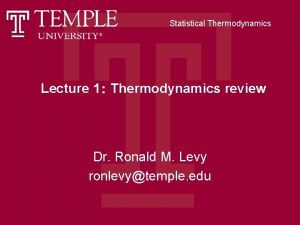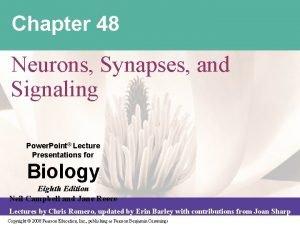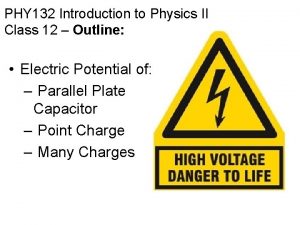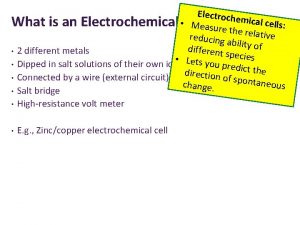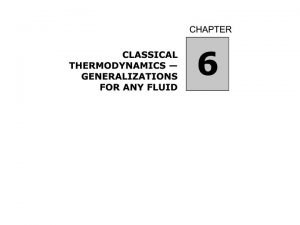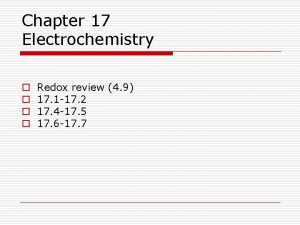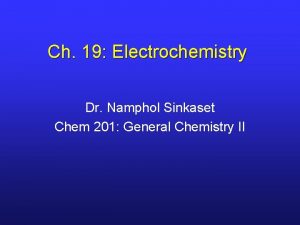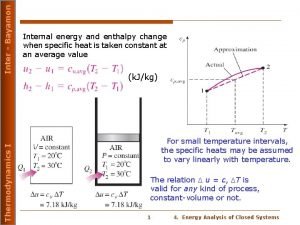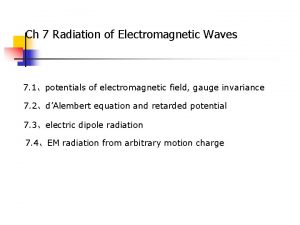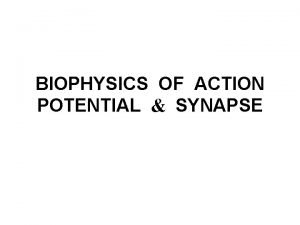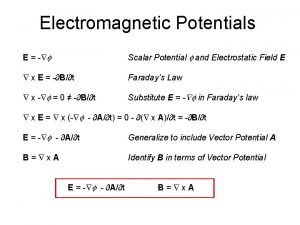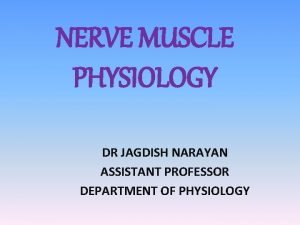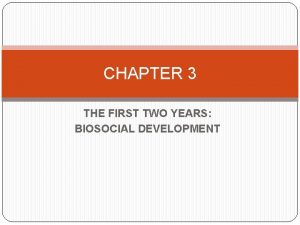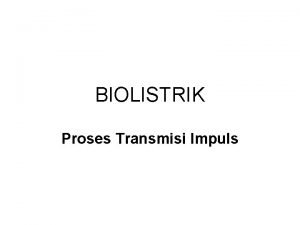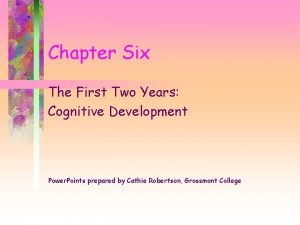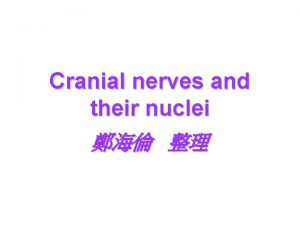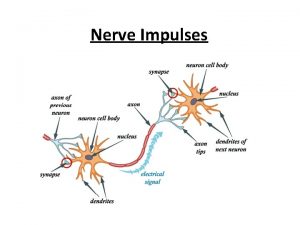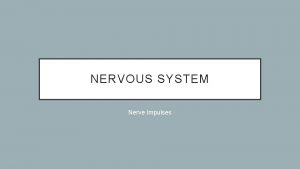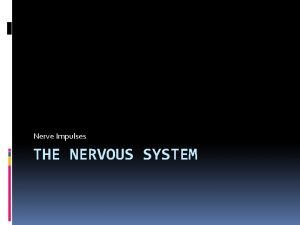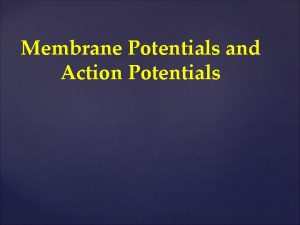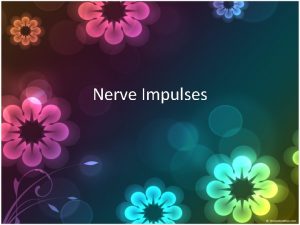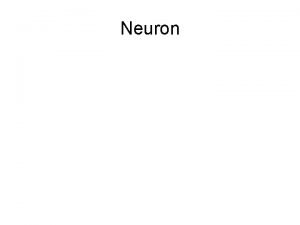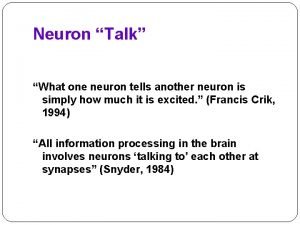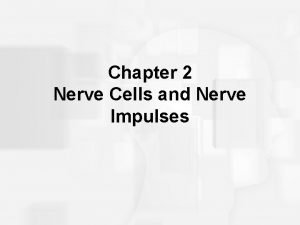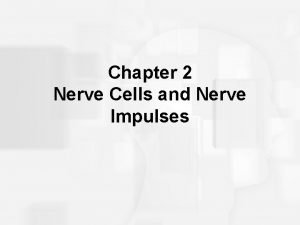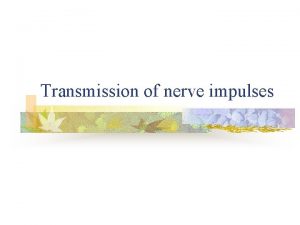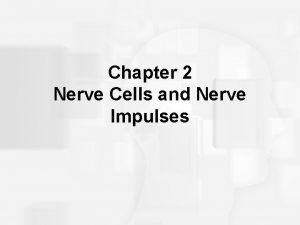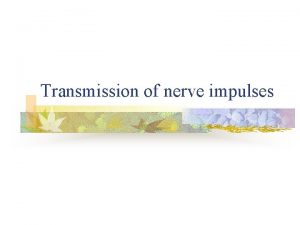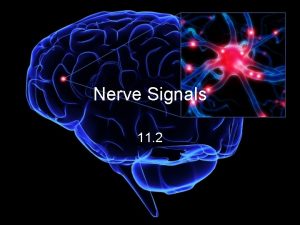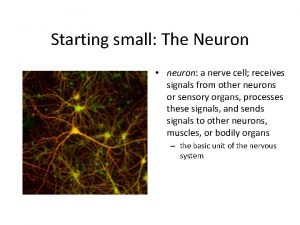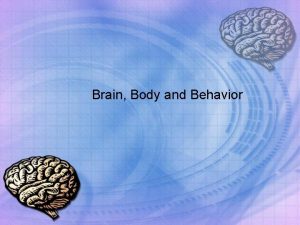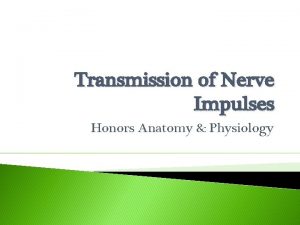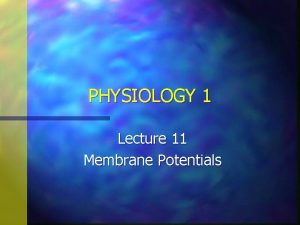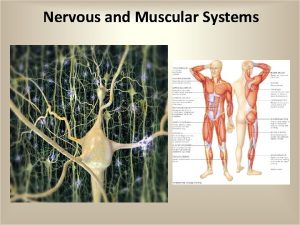Nerve Impulses Neuron Physiology Action Potentials nerve impulses


























- Slides: 26

Nerve Impulses

Neuron Physiology Action Potentials- nerve impulses which are sent by a change in electrical charge in the cell membrane. Depends on ions inside and outside of the neuron cell A resting neuron: • Sodium (Na+) highly concentrated outside of cells • Potassium (K+) highly concentrated inside cells

Ion Movement Passive transport-Ions move from high concentration to a low concentration passively without using Energy (ATP) by 2 methods: • Diffusion-molecule cross membranes from high concentration to low concentrations • Facilitated diffusion-Ions move with the gradient from a high to low concentration when protein channels in the membrane are open

Ion Movement Active Transport- ions move against gradients using pumps and ATP • Na+/K+ pumps- move ions actively using ATP against their gradients Na+ is moved from low concentrations to high concentration and K+ is moved from low concentrations to high concentrations.

Creating a Resting Potential in a Neuron (-70 m. V)

An Action Potential The change in electrical potential associated with the passage of an impulse along the membrane of a nerve cell.

Stages of Nerve Impulses Stage 1: Resting Potential • Neuron’s resting potential=-70 m. V • Inside=high concentrations of negatively charged ions and high concentrations of K+ • Outside=high concentrations of Na+

Stages of Nerve Impulses • Stage 2: Depolarization (-62 m. V) • Gates in the axon called ion channels open when a neuron is stimulated • Na+ rushes into the axon giving it a brief positive electrical charge and the axon becomes depolarized

Stages of Nerve Impulses • Stage 3: Threshold (-55 m. V) • Threshold- is the minimum for a neuron to fire • It is reached once enough sodium rushes in to make the inside of the neuron(-55 m. V).

Stages of Nerve Impulses • Stage 4: Repolarization • This occurs as K+ channels open and K+ moves outward causing inside of membrane to become negative again. • At the same time Na+/K+ pumps move Na+ back out of the cell.

Stages of Nerve Impulses Stage 5: Hyperpolarization. • Hyperpolarization occurs when the voltage is below the resting potential • A neuron cannot produce a new action potential • This is the refractory period

A Nerve Impulse- a series of action potentials Action Potential

Refractory Period For a short period after the passage of an impulse, the threshold for stimulation is raised, so it limits the frequency of impulses and ensures unidirectional travel of impulse.


All or None Response The strength of a response of a nerve cell or muscle fiber is not dependent upon the strength of the stimulus. If a stimulus is above a certain threshold, a nerve or muscle fiber will fire. Full response or no response at all. "The all-or-none law guarantees that once an action potential is generated it is always full size, minimizing the possibility that information will be lost along the way. "

What happens when the nerve impulse reaches the end of the axon? • Axon terminals – Are found next to another neuron (as shown) or a muscle or gland • The gap is called a synapse Synapse Action • Neurotransmitters are released at the synapse to pass the message to the next neuron.

Synapse

Neurotransmitters released at synapse

Saltatory nerve impulse conduction The action potential jumps large distances from node to node, a process that is called saltatory propagation. This speeds up the transmission of impulses.

Myelinated vs. unmyelinated neurons

Speed of a Nerve impulse • Temperature - higher the temperature= faster speed. Warm-blooded animals have faster responses than cold-blooded. • Axon diameter - larger the diameter= faster speed. Marine invertebrates, (who live at temperatures close to 0°C), developed thick axons to speed up their responses. This explains why squid have their giant axons. • Myelin sheath - Only vertebrates have a myelin sheath surrounding their neurons. The voltage-gated ion channels are found only at the nodes of Ranvier, and between nodes myelin sheath acts as a good electrical insulator. Increases the speed of propagation dramatically. v unmyelinated neurons –travel at about of 1 meters/second v myelinated neurons-travel at about 100 meters/second v Depending on the type of fiber, modern measurements are from 6 -122 m/s

Central Nervous System - Spinal Cord Figs 9. 22, 9. 23 & 9. 24

What is a Reflex Arc? • We need to detect a change in the environment (a stimulus) and react to the change (a response) in a way that maintains homeostasis. • When you do this without thinking, it is called a reflex. • Reflexes are not immediately processed by the brain

Reflex Arc

Name the Neuron

Reflex Arcs Stimulus Response Aroma of a burger Salivation Nasty odor Nausea Bright light in the eyes Pupil dilates Insect flying to the eye Blinking Muscles in the leg relax Knee jerk
 Incoming sensory impulses and outgoing motor impulses
Incoming sensory impulses and outgoing motor impulses Transmits nerve impulses
Transmits nerve impulses Transmits nerve impulses
Transmits nerve impulses Neuron physiology
Neuron physiology Standard cell potentials
Standard cell potentials Function of synapse
Function of synapse Thermodynamic potentials
Thermodynamic potentials Postsynaptic potentials
Postsynaptic potentials Two protons one after the other are launched
Two protons one after the other are launched Eθcell
Eθcell Action potential resting potential
Action potential resting potential Thermodynamic potentials
Thermodynamic potentials Standard reduction potential table
Standard reduction potential table Use the tabulated half-cell potentials to calculate
Use the tabulated half-cell potentials to calculate Types of graded potentials
Types of graded potentials Enthalpy vs internal energy
Enthalpy vs internal energy Lienard-wiechert potentials
Lienard-wiechert potentials Thermodynamic potentials
Thermodynamic potentials What are electrical synapses
What are electrical synapses Define graded potential
Define graded potential Scalar magnetic potential
Scalar magnetic potential Nerve muscle physiology
Nerve muscle physiology Social impulses foster infant language
Social impulses foster infant language Transmisi impuls saraf
Transmisi impuls saraf Social impulses foster infant language
Social impulses foster infant language Metabolic acidosis abg
Metabolic acidosis abg Trigeminal nerve which cranial nerve
Trigeminal nerve which cranial nerve


